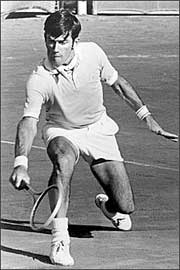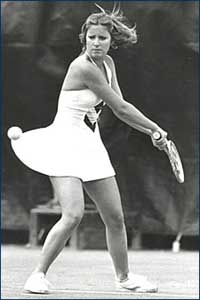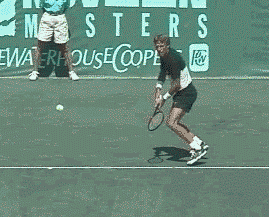
The Evolution of Tennis Strategies
by Dave Smith
|

Players like Agassi have shown the return can be an “equalizer” to
today’s powerful serves. |
Like it or not, the game of tennis has changed over its historical
course. Some say for the better, others are not so sure. Certainly the
game’s general popularity has seen several highs and lows over time. Some
rationalize that the game’s shifting popularity is based on these
evolutionary changes…namely, changes in power and, consequently, changes
in strategy.
There seems to be a split among tennis enthusiasts on whether or not
these changes are good for the game: On
one side are those who favor the “old school” cat and mouse
strategies predominately centered on slices, finesse shots, and approach
and volleys. On the other side are those who favor the modern game of
powerful serves and groundstrokes interlaced with volleys, drops and
angles.
I have received passionate pleas from individuals favoring a return to
“traditional” strategies of chip-and-charge offensive game plans or
serve-and-volley strategies. The greatest complaint expressed, is the lack
of interesting points, especially in men’s tennis.
Certainly, over the course of the last ten or fifteen years, men’s
tennis has evolved into a serve-fest, with many points being determined
quickly, usually with a potent serve and an occasional volley or
groundstroke winner or forced error. However, the last couple years have
ushered in yet another subtle shift. It appears that the effectiveness of
the return-of-serve has caught up to that of the serve, allowing the game
to evolve back into points that include rallies, exciting ones at that!
Even on fast surfaces such as the grass at Wimbledon, rallies once
again are in many cases becoming the norm as opposed to the exception.
Despite the plethora of big servers like Sampras, Roddick, Safin, and
Ivanisevic, rallies at Wimbledon and other Grand Slam events have become
longer and more exciting.
|

Players up to, and including, the McEnroe era relied heavily on the
slice to set up points. Today it's used as a defensive tactic or as a
change of pace. |
However, the game today is played differently then it was when wooden
racquets ruled the court and grass was the predominate surface. The longer rallies described include a barrage of incredibly
powerful groundstrokes and serves, spectacular topspin angles and displays
of incredible athleticism and conditioning unimaginable even a few years
ago. Subsequently, the strategy of the game has changed from the days of
‘chip and charge’ to a more resolute game of cat and mouse played between
players who posses weapons of mass destruction!
In Part 1 of this series, I
discussed the evolution of tennis strokes and the development of the
topspin groundstroke as being the root of tennis evolution. Players who
wanted more power needed a technique to help keep more powerful shots
in play. Of course, the answer to that problem was topspin. Understanding
the physics of spin can help us understand the how and why of changes in
tennis strategies.
The advent and propagation of greater topspin on groundstrokes has had
a significant impact on how the game is played at the pro level. On the
other hand, the “traditional”
shot-of-choice, the slice, has seen virtually no change in its
presentation for perhaps one hundred years. The simple physics of the
slice makes it almost impervious to the kind of changes we have seen
associated with topspin shots.
One of the contributing factors for the slice becoming less a weapon
and more a situational stroke is the change in court surfaces. Prior to
1975, three of the four Grand Slams (U.S. Open, Australian Open, and
Wimbledon) were played on grass. Since the fast surface of grass arguably
favored net-attacking strategies, most top players adopted this style of
play. (I say arguably since Bjorn Borg, a baseline player extraordinaire,
ruled the grass at Wimbledon in winning 5 of his 11 major titles there!)
However, today, the only Grand Slam event still played on grass is
Wimbledon.
With a variety of court surfaces, from hard courts to grass, from
synthetic surfaces to clay, players today must be able to adapt and devise
game plans that not only work for them, but work for the playing surface
as well.
How has this consequential shift in groundstroke preference led
specifically to the changes in tennis strategy? Before we can address this
question, we must clearly identify what those strategies are.
  
Attacking players of past eras; Ken Rosewall, Rod Laver, and John
McEnroe all featured game strategies that centered around getting to the
net. |
Strategies of Tennis
For simplification, tennis can be reduced to two basic strategies, attacking and retrieving.
Attacking strategies include two distinct tactics:
|

It really wasn’t until the late 1960’s that Billie Jean King
demonstrated women too could be aggressive net players |
- Serve and volley
- Chip and charge
Most players of the past executed game plans that revolved around these
two strategies including Fred Perry, Jack Kramer, Pancho Gonzalez, Don
Budge, Ken Rosewall, and Rod Laver.
Traditionally, women did not attack
the net as often nor with as much aggressive style as men. It really
wasn’t until the late 1960’s and early 70’s that Billie Jean King and
compatriot Rosie Casals demonstrated that women too, could be aggressive
net players. King, Casals, the Brit, Virgina Wade, Australian Evonne
Goolagong and especially Martina Navratilova, set the stage for other women to play a more aggressive, all-court style of
play.
Certainly, a host of champions have utilized this attacking strategy
within the past three decades. Perhaps beginning with Stan Smith, players
like John McEnroe, Arthur Ashe and Stefan Edberg led
the way for the likes of Pete Sampras, Boris Becker, Patrick Rafter and
Tim Henman to make their marks as aggressive net-seeking attackers.
The more defensive “retrieving” style of play can be characterized by
players camping out at the baseline, typically waiting for their opponents
to make a mistake. Notable players who have successfully utilized this
game plan include Bjorn Borg, Michael Chang, Chris Evert, and Tracy Austin. Even a young Andre Agassi played
this decisively baseline game.
|
 
Players like Chris Evert (left) and Tracy Austin preferred a more
defensive, retrieving style of play. |
Strategies Today
Top
players of today possess such massive topspin groundstrokes that they
often make playing the baseline an aggressive “attacking” game in itself!
Never has there been so much power addressed to balls from behind the
baseline. In my opinion, this power from the backcourt has brought about
the greatest change in player strategies.
Topspin Versus Slice
As I have mentioned, topspin mechanics have taken on new levels of
offensiveness making it much less certain that a player can stroll up to
the net and effectively put away a volley. And, far less often today do
we see the slice utilized strictly as an approach shot.
The slice is still used by most players—including two-handed
backhanders (using one hand in most cases)—as both a defensive stroke as
well as a change-of-pace ploy. However, as the power of groundstrokes and
passing shots continue to intensify, the specific net-attacking only
strategies of the past are becoming more of a liability for those who attempt them.
For this reason, the
evolution of tennis has gradually moved away from the dominant net-attacking
strategies of the past into a more methodical dissection of opponents through
the weaponry of imposing groundstrokes. Only then, when players get their
opponents in trouble through a course of spin-related power mixed with
geometric placements, will they venture to the net for the anticipated
volley winner they so richly deserve.
|

Bjorn Borg maintained a steel-like
patience opponents found tough to crack. |
Simply playing a retrieving singles strategy, where players camp out at
the baseline and engage in a slugfest of groundstrokes, has proven to be
somewhat limiting among many of the top up-and-coming players. Much like
playing a strategy that consists predominately of serve-and-volley or
chip and charge points, hanging back and hitting groundstrokes almost
exclusively has become less successful in today’s professional arena.
I
remember watching how uncomfortable past baseline players became anytime
they approached the net. Not so long ago, Michael Chang looked like a fish
out of water when forced to come up and volley. Ivan Lendl liked to stay
back with patience and topspin as his main weaponry. He too did
not look comfortable during times he would approach the net until
later in his career. Ironically, even as Chang developed a respectable net
game as his career proceeded, he never gained the kind of success he
enjoyed when he was strictly a baseline retriever.
Notwithstanding, the vast majority of men and women tour professionals
today play a more identifiable “all-court” game. Their volley winners
often occur after a chess-like series of powerful, precision groundstrokes
open up the court. Few champions of
today’s modern game have been able to win consistently without some mastery
of all
the weapons available.
|

Even extreme groundstrokers like Andy Roddick have to adapt to an
all-court style if they are to advance up the rankings. |
In many cases, these heavy-handed topspin groundstrokes force a point
to end even before a weak shot is parlayed into a winning volley. Thus,
many people might consider this strategy as a “baseline-only” contest
when in fact, it is a constant battle of respect and confidence between
very skilled performers who can play the whole court with
expertise.
Players who could be arguably labeled as “All-Court” players include
Taylor Dent, Tommy Haas, and Roger Federer. Andy Roddick appears to be
making a move to become a more offensive net-attacking player in recent
months.
On the women’s side, we see very few true net-attacking strategists.
However, with the possible exception of Monica Seles, most all the top WTA
players can and do play the net when presented with the opportunity. Top
ranked players such as the Williams sisters, Henin and Clijsters, and even
the slumping Capriati and the vanishing Hingis possess excellent net
skills and strategies to go along with their topspin power from the
baseline.
Racquet Technology
One last contributing factor to the evolution of tennis strategies (and
certainly not the least!) is the revolution of modern racquet technology.
The influx of ultra light, powerful tennis frames seems to have ushered in
a new physical component to the modern game. The self-limiting speed of
shots due to the seemingly restrictive power of wooden racquets has given
way to a nearly freewheeling sense of power through racquets constructed
of space age materials. These lighter, stiffer racquets allow players
(particularly in the women's game) to generate much faster racquethead
speed which leads to an increase in the amount of topspin pro players can
create. More topspin can equate into substantially more power in the
topspin groundstroke game.
Even as these advanced racquets have helped create serve speeds
unimaginable a few short decades ago, current players are reluctant to try
to advance themselves to the net following such potent initial shots. This
says a lot for the respect for the return of serve and groundstrokes in
general. It makes sense: The same racquethead speed generated on serves
due to racquet construction is also available for use in returning such
shots.
Conclusion
So, is the serve and volley game gone the way of the dinosaur and the
eight track tape? Perhaps not. Tennis is a dynamic game and strategies as
well as players will continue to evolve. As players discover new ways to
combat present tactics, popular strategies of today may become historic
strategies tomorrow. And strategies of the past may indeed come full
circle and become strategies for the future!
Next Up
In Part 3 of this series on the Evolution of Tennis, I will
discuss the evolution of the backhand, specifically addressing the change
from one hand to two and the different types of two-handed backhands that
we have seen among top players.
 Your comments are welcome. Let us know what you think about this article by emailing
us here at TennisONE. Your comments are welcome. Let us know what you think about this article by emailing
us here at TennisONE.
David W. Smith is the Director of Tennis for the St. George Tennis Academy
in St. George Utah. He has been a featured writer in USPTA’s magazine
ADDvantage in addition to having over 50 published articles in various
publications. David has taught over 3000 players including many top
national and world ranked players. He can be reached at ACRpres1@msn.com |